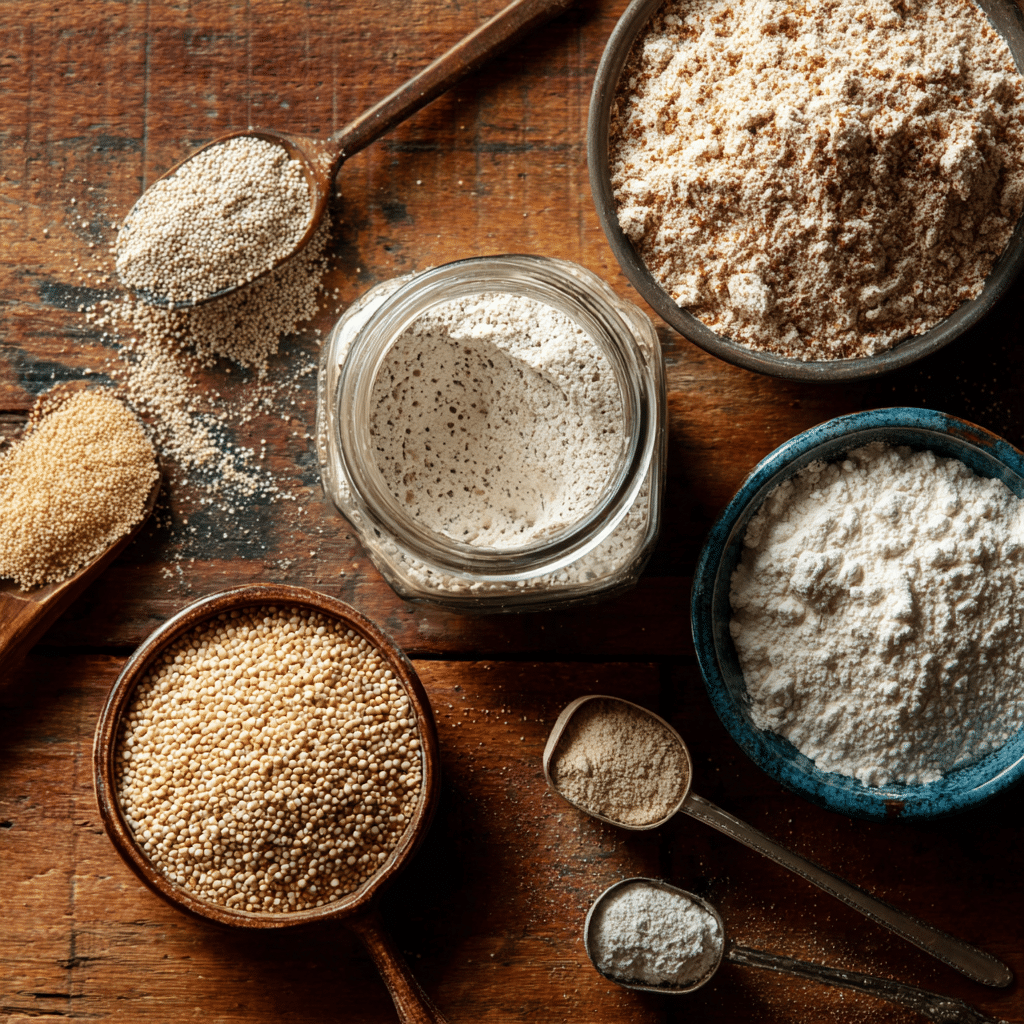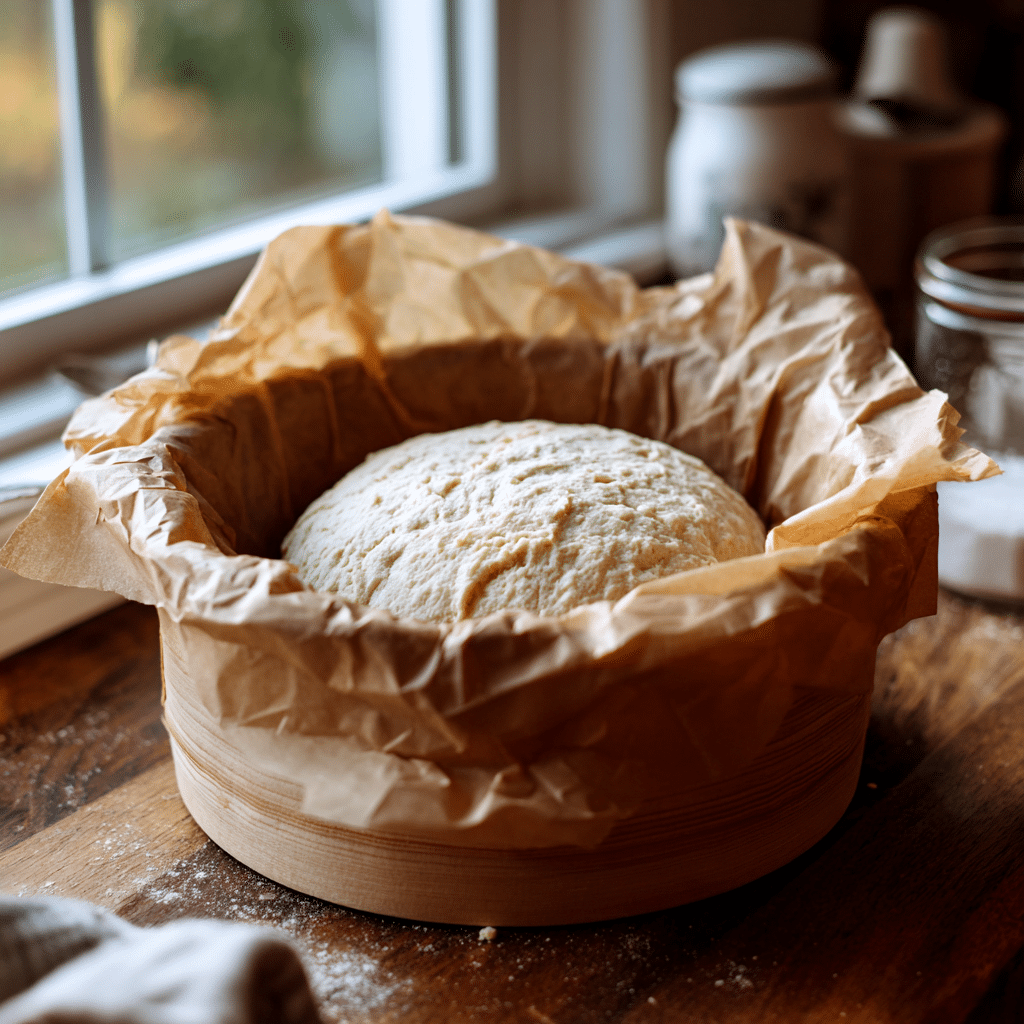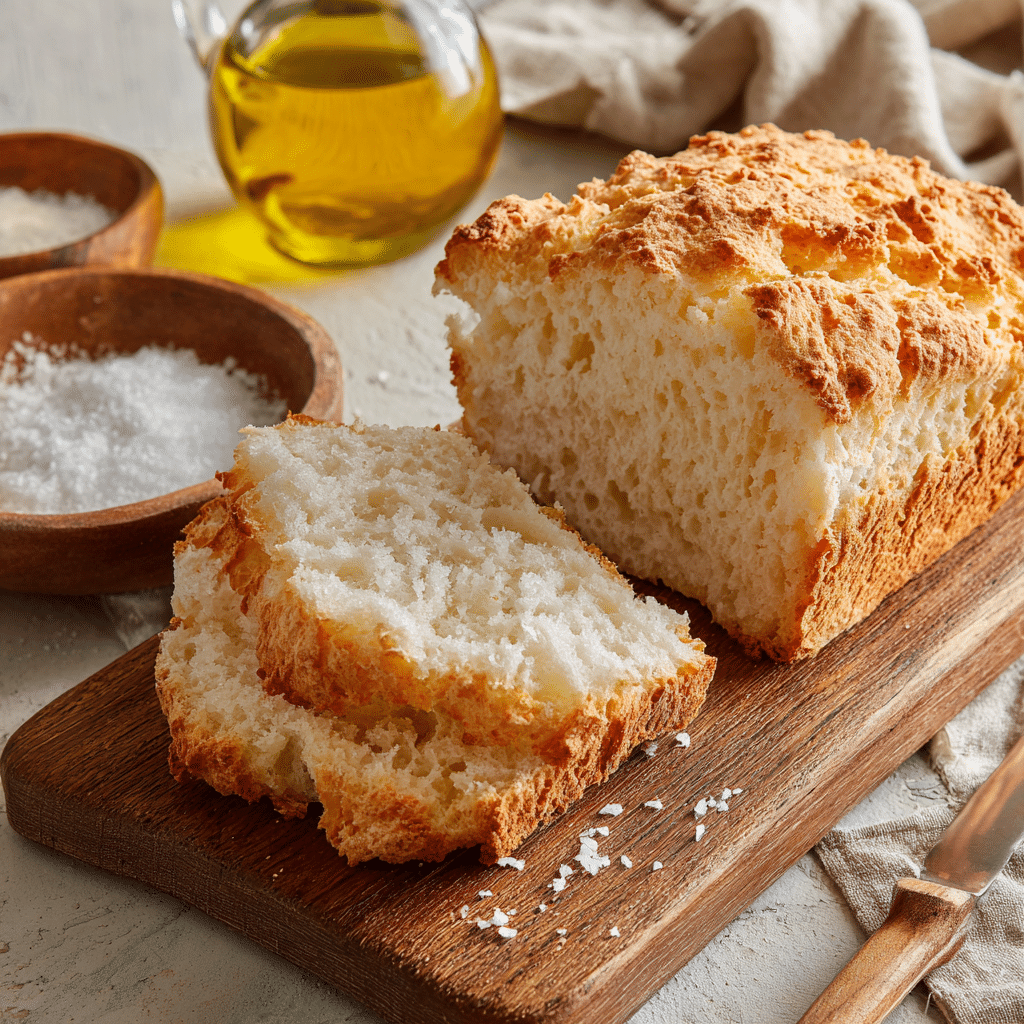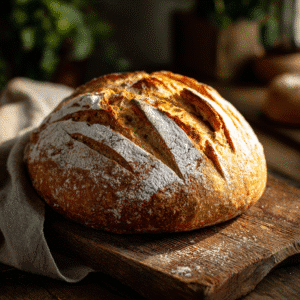Levain bread gluten free is no longer just a dream it’s a bold reality for those of us who love rustic sourdough but need to skip the wheat. I still remember the first time I tasted levain bread as a culinary student in Tuscany. The chewy crust, the wild aroma, that unmistakable tang it was love at first bite. Years later, when I learned I was gluten intolerant, I wasn’t ready to say goodbye to that flavor.
So I got to work. After months of experiments and a few flat loaves, I cracked the code on a gluten free version that actually felt alive bubbly starter, golden crust, tangy crumb. In this guide, I’ll walk you through what makes levain bread special and exactly how to make it gluten free at home. I’ll also answer the top questions people ask about sourdough, starters, and safety for celiacs. Along the way, I’ll share related bakes like these soft gluten-free dinner rolls and rustic no-knead gluten-free bread to keep your oven busy.
Table of Contents
What Is Levain Bread and Can It Be Gluten Free?
The Magic of Levain Bread
Levain bread is a type of sourdough that relies on a fermented starter called “levain” made from flour and water. Unlike store-bought yeast, levain captures wild yeasts and lactobacilli from the air, producing deep flavor and a satisfying chew. The long fermentation time develops both complexity and nutrition, which is why it’s so beloved by bakers.
The problem? Traditional levain uses wheat or rye, which contain gluten. But don’t worry you can still enjoy the same artisanal quality by creating your levain bread gluten free using a starter built with brown rice flour, sorghum, or even teff. These naturally gluten-free grains ferment beautifully, giving you an active, bubbly starter in just about a week.
Want an easier loaf while your starter matures? Try this soft homemade gluten-free bread for a beginner-friendly option.
Is Sourdough Naturally Gluten Free?
One of the biggest myths in the baking world is that all sourdough is safe for gluten sensitive folks. That’s not true. Even though long fermentation breaks down some gluten, the levels are still unsafe for celiacs or those with severe intolerance. That’s why it’s essential to make levain bread gluten free from the start, using flours and tools that have never come into contact with gluten.

How to Make a Gluten Free Levain Starter
Building Your Starter from Scratch
Making levain bread gluten free starts with one essential: an active gluten free starter. This bubbly, living mixture of flour and water replaces commercial yeast and powers the fermentation that gives levain its signature tang and rise. While traditional starters rely on wheat, a gluten free levain can be just as powerful with the right ingredients and a little care.
To make your own starter, combine equal parts gluten free flour and filtered water in a clean glass jar. Brown rice flour is a top choice for beginners because it ferments consistently and creates a stable base. You can also use sorghum, buckwheat, or a blend of naturally gluten free flours. Make sure they’re certified gluten-free to avoid cross contamination.
- Day 1: Mix 30g flour and 30g water. Stir well, cover loosely, and leave it at room temperature.
- Days 2–4: Each day, discard half and feed it fresh flour and water. Bubbles mean it’s alive!
- Days 5–7: By now, your gluten-free starter should double in volume and smell pleasantly sour.
While it takes time, this is the most critical step in making authentic levain bread gluten free at home. If you’re craving bread while your starter matures, check out this no-knead gluten-free bread for a quick fix.
Feeding and Maintaining It
A well fed starter is the secret to successful levain bread gluten free recipes. After the first week, you can store it in the fridge and feed it weekly. Always use filtered water and clean tools wild yeast is sensitive. If you see mold or pink streaks, it’s best to toss it and start over.
Once it’s active and reliable, your gluten-free starter can be used for everything from artisan loaves to these gluten-free sourdough cinnamon rolls.

3: Baking Techniques for Levain Bread Gluten Free
Getting the Right Texture Without Gluten
The biggest challenge when making levain bread gluten free is texture. Without gluten’s elasticity, your dough won’t stretch or trap air the same way. But with the right ingredients and process, you can still get that open crumb, crispy crust, and slight chew you’d expect from traditional sourdough.
First, structure matters. A combination of gluten free flours works best think sorghum, brown rice, teff, and millet. Don’t rely on just one flour. Each brings something different: sorghum adds softness, teff brings color, and brown rice gives body.
Next up is psyllium husk. This is your gluten replacement. It acts like a gel, helping the dough hold shape and stay hydrated. Chia seeds and flaxseed meal can also work, but psyllium gives the most consistent results in levain bread gluten free baking.
Hydration is key. Your dough should feel wet almost like a thick batter. Don’t over flour it. Wet dough rises better and creates that desirable airiness. If you’re unsure about hydration, test your skills first with this gluten-free dairy-free banana bread to get a feel for moisture levels.
Proofing, Scoring, and Baking
Give your dough time. Fermentation is what gives levain bread gluten free its rich flavor. Once shaped, let it proof in a banneton or lined bowl for 3 to 6 hours at room temperature or overnight in the fridge for deeper flavor.
When ready to bake, preheat a Dutch oven to 450°F. Scoring the dough before baking helps control the rise and gives your loaf that artisan look. Bake covered for 25 minutes, then uncover for another 20 to crisp the crust.
For more flavor packed ideas, try these golden gluten-free zucchini bread variations that also use moisture retaining ingredients.
Safety, Storage & Celiac Concerns for Levain Bread Gluten Free

Is It Safe for Celiacs?
When it comes to levain bread gluten free, safety is everything especially for people with celiac disease. Not all sourdough is safe, even if it claims to be “low gluten.” Fermentation alone doesn’t remove enough gluten to meet medical safety standards.
To make levain bread that’s truly gluten-free, you must start with certified gluten-free flours and keep all tools and surfaces separate from gluten containing ingredients. That includes your levain starter. Once contaminated, a starter can’t be “cleaned.” It’s safer to begin a fresh batch using flours like buckwheat, millet, or brown rice.
I learned this the hard way after feeling sick from cross contact with wheat. Since then, I’ve followed strict protocols, and every recipe I now create, like these gluten-free biscuits, is made in a celiac-safe kitchen.
Storage, Slicing & Serving Tips
Once baked, levain bread gluten free stores best at room temperature for up to 3 days, wrapped in a clean cloth or parchment paper. Avoid sealing it in plastic it softens the crust and can create condensation.
For longer storage, slice and freeze it. Toasting brings back the chew and crunch, especially for heartier loaves. I often pair mine with smashed avocado, herbed ricotta, or a drizzle of olive oil and sea salt. If you’re serving brunch, it goes beautifully with a slice of gluten-free carrot cake for a sweet-savory combo.
To reheat, skip the microwave use the oven or toaster for better texture. Gluten-free levain is more delicate but equally satisfying when treated with care.
Whether you’re new to sourdough or a seasoned baker going gluten free, this bread is proof you don’t have to give up quality or tradition.
Conclusion
Making levain bread gluten free is more than possible it’s delicious, satisfying, and empowering. With the right flours, a living starter, and patience, you can recreate that old world sourdough magic without a speck of gluten. Whether you’re baking for health, flavor, or the joy of creation, gluten-free levain offers a slice of comfort with none of the compromise.
From beginner friendly no-knead bread to creative spins like gluten-free zucchini bread, your gluten free baking journey is just beginning. Stick with it, feed that starter, and soon you’ll be pulling artisan loaves from your oven that nourish both body and soul.
Are any sourdough breads gluten free?
Most sourdough breads are not gluten-free because they use wheat or rye. However, sourdough can be gluten free if made entirely from gluten free flours and a gluten free starter. Our gluten-free sourdough cinnamon rolls are a great example of a safe, flavorful option.
What is levain bread made of?
Traditional levain bread is made from flour, water, salt, and a natural sourdough starter. For levain bread gluten free, we use gluten-free flours like brown rice, teff, or sorghum, combined with psyllium husk for structure and a gluten free starter for fermentation.
Which breads are gluten free?
Gluten free breads use flours like rice, almond, sorghum, and tapioca instead of wheat. You’ll find everything from gluten-free naan bread to soft homemade gluten-free bread right here on the blog.
Is sourdough starter gluten free?
Only if it’s made from gluten free flour. A standard starter made from wheat or rye contains gluten. To keep your levain bread gluten free, always use a gluten free starter built from safe flours and clean tools.
Can celiacs eat gluten free cookies?
Yes but only if those cookies are made in a certified gluten free environment. Even trace amounts of gluten can trigger reactions in people with celiac disease. Always check labels or bake your own using safe recipes like our low sugar gluten-free cookies.

Levain Bread Gluten Free
Ingredients
- 30 g gluten-free brown rice flour for starter
- 30 g filtered water for starter
- 1 1/4 cups brown rice flour
- 3/4 cup sorghum flour
- 1/2 cup teff flour
- 2 tbsp psyllium husk powder
- 1 1/4 cups warm filtered water
- 1 tsp salt
- Gluten-free levain starter active and bubbly
Instructions
- To create the levain starter: Mix 30g brown rice flour with 30g filtered water in a jar. Cover loosely and leave at room temperature.
- Feed the starter daily by discarding half and adding 30g flour and 30g water. Continue for 5–7 days until bubbly and sour-smelling.
- To make the dough: In a bowl, mix flours, psyllium husk, and salt. Stir in water and mix well. Let sit for 5 minutes.
- Add 1/2 cup of your active levain starter and mix until combined. The dough will be sticky and thick like a batter.
- Shape into a round and place in a parchment-lined bowl or banneton. Cover and let proof for 3–6 hours at room temp or overnight in fridge.
- Preheat Dutch oven to 450°F (230°C). Score the top of your loaf.
- Bake covered for 25 minutes, then uncovered for 20 minutes or until golden and crusty.
- Cool on a rack before slicing. Store wrapped in a cloth or freeze sliced.

